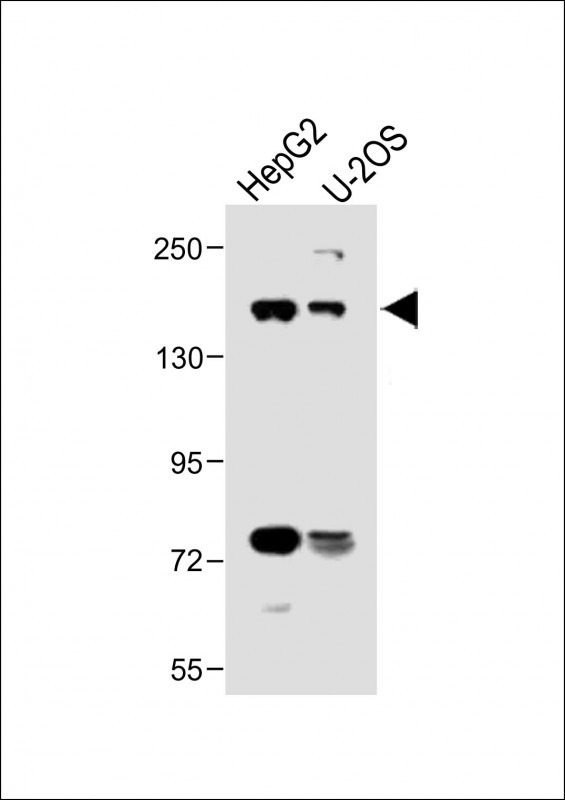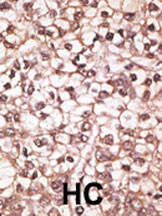ABCB4 Antibody (Center)
Purified Rabbit Polyclonal Antibody (Pab)
- 产品详情
- 文献引用 : 1
- 实验流程
- 背景知识
Application
| WB, IHC-P, E |
|---|---|
| Primary Accession | P21439 |
| Reactivity | Human, Rat, Mouse |
| Host | Rabbit |
| Clonality | Polyclonal |
| Isotype | Rabbit IgG |
| Calculated MW | 141523 Da |
| Antigen Region | 624-654 aa |
| Gene ID | 5244 |
|---|---|
| Other Names | Multidrug resistance protein 3, ATP-binding cassette sub-family B member 4, P-glycoprotein 3, ABCB4, MDR3, PGY3 |
| Target/Specificity | This ABCB4 antibody is generated from rabbits immunized with a KLH conjugated synthetic peptide between 624-654 amino acids from the Central region of human ABCB4. |
| Dilution | WB~~1:500 IHC-P~~1:100~500 E~~Use at an assay dependent concentration. |
| Format | Purified polyclonal antibody supplied in PBS with 0.09% (W/V) sodium azide. This antibody is purified through a protein A column, followed by peptide affinity purification. |
| Storage | Maintain refrigerated at 2-8°C for up to 2 weeks. For long term storage store at -20°C in small aliquots to prevent freeze-thaw cycles. |
| Precautions | ABCB4 Antibody (Center) is for research use only and not for use in diagnostic or therapeutic procedures. |
| Name | ABCB4 (HGNC:45) |
|---|---|
| Function | [Isoform 1]: Energy-dependent phospholipid efflux translocator that acts as a positive regulator of biliary lipid secretion. Functions as a floppase that translocates specifically phosphatidylcholine (PC) from the inner to the outer leaflet of the canalicular membrane bilayer into the canaliculi of hepatocytes. Translocation of PC makes the biliary phospholipids available for extraction into the canaliculi lumen by bile salt mixed micelles and therefore protects the biliary tree from the detergent activity of bile salts (PubMed:17523162, PubMed:21820390, PubMed:23468132, PubMed:24594635, PubMed:24723470, PubMed:24806754, PubMed:31873305, PubMed:7957936, PubMed:8898203, PubMed:9366571). Plays a role in the recruitment of phosphatidylcholine (PC), phosphatidylethanolamine (PE) and sphingomyelin (SM) molecules to nonraft membranes and to further enrichment of SM and cholesterol in raft membranes in hepatocytes (PubMed:23468132). Required for proper phospholipid bile formation (By similarity). Indirectly involved in cholesterol efflux activity from hepatocytes into the canalicular lumen in the presence of bile salts in an ATP-dependent manner (PubMed:24045840). Promotes biliary phospholipid secretion as canaliculi-containing vesicles from the canalicular plasma membrane (PubMed:28012258, PubMed:9366571). In cooperation with ATP8B1, functions to protect hepatocytes from the deleterious detergent activity of bile salts (PubMed:21820390). Does not confer multidrug resistance (By similarity). |
| Cellular Location | Cell membrane; Multi-pass membrane protein {ECO:0000255|PROSITE-ProRule:PRU00441}. Apical cell membrane; Multi-pass membrane protein {ECO:0000255|PROSITE-ProRule:PRU00441}. Membrane raft. Cytoplasm Cytoplasmic vesicle, clathrin-coated vesicle {ECO:0000250|UniProtKB:Q08201}. Note=Localized at the apical canalicular membrane of the epithelial cells lining the lumen of the bile canaliculi and biliary ductules (By similarity). Transported from the Golgi to the apical bile canalicular membrane in a RACK1-dependent manner (PubMed:19674157). Redistributed into pseudocanaliculi formed between cells in a bezafibrate- or PPARA-dependent manner (PubMed:15258199). Localized preferentially in lipid nonraft domains of canalicular plasma membranes (PubMed:23468132) {ECO:0000250|UniProtKB:P21440, ECO:0000269|PubMed:15258199, ECO:0000269|PubMed:19674157, ECO:0000269|PubMed:23468132} |
For Research Use Only. Not For Use In Diagnostic Procedures.

Provided below are standard protocols that you may find useful for product applications.
BACKGROUND
The membrane-associated protein encoded ABCB4 is a member of the superfamily of ATP-binding cassette (ABC) transporters. ABC proteins transport various molecules across extra- and intra-cellular membranes. ABC genes are divided into seven distinct subfamilies (ABC1, MDR/TAP, MRP, ALD, OABP, GCN20, White). This protein is a member of the MDR/TAP subfamily. Members of the MDR/TAP subfamily are involved in multidrug resistance as well as antigen presentation. This gene encodes a full transporter and member of the p-glycoprotein family of membrane proteins with phosphatidylcholine as its substrate. The function of this protein has not yet been determined; however, it may involve transport of phospholipids from liver hepatocytes into bile. Alternative splicing of this gene results in several products of undetermined function.
REFERENCES
Eloranta, M.L., et al., Eur J Obstet Gynecol Reprod Biol 105(2):132-135 (2002).
Eloranta, M.L., et al., Eur J Obstet Gynecol Reprod Biol 104(2):109-112 (2002).
Jacquemin, E., Semin. Liver Dis. 21(4):551-562 (2001).
Smit, J.J., et al., Biochim. Biophys. Acta 1261(1):44-56 (1995).
Ruetz, S., et al., Cell 77(7):1071-1081 (1994).
终于等到您。ABCEPTA(百远生物)抗体产品。
点击下方“我要评价 ”按钮提交您的反馈信息,您的反馈和评价是我们最宝贵的财富之一,
我们将在1-3个工作日内处理您的反馈信息。
如有疑问,联系:0512-88856768 tech-china@abcepta.com.






















 癌症的基本特征包括细胞增殖、血管生成、迁移、凋亡逃避机制和细胞永生等。找到癌症发生过程中这些通路的关键标记物和对应的抗体用于检测至关重要。
癌症的基本特征包括细胞增殖、血管生成、迁移、凋亡逃避机制和细胞永生等。找到癌症发生过程中这些通路的关键标记物和对应的抗体用于检测至关重要。 为您推荐一个泛素化位点预测神器——泛素化分析工具,可以为您的蛋白的泛素化位点作出预测和评分。
为您推荐一个泛素化位点预测神器——泛素化分析工具,可以为您的蛋白的泛素化位点作出预测和评分。 细胞自噬受体图形绘图工具为你的蛋白的细胞受体结合位点作出预测和评分,识别结合到自噬通路中的蛋白是非常重要的,便于让我们理解自噬在正常生理、病理过程中的作用,如发育、细胞分化、神经退化性疾病、压力条件下、感染和癌症。
细胞自噬受体图形绘图工具为你的蛋白的细胞受体结合位点作出预测和评分,识别结合到自噬通路中的蛋白是非常重要的,便于让我们理解自噬在正常生理、病理过程中的作用,如发育、细胞分化、神经退化性疾病、压力条件下、感染和癌症。







